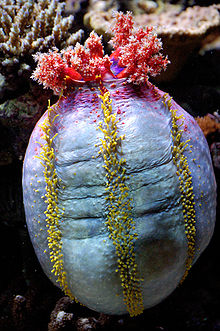Pseudocolochirus violaceus
| Sea apple | |
|---|---|
 |
|
| Pseudocolochirus violaceus | |
| Scientific classification | |
| Kingdom: | Animalia |
| Phylum: | Echinodermata |
| Class: | Holothuroidea |
| Order: | Dendrochirotida |
| Family: | Cucumariidae |
| Genus: |
Paracucumaria Pseudocolochirus |
| Species | |
|
|
| Synonyms | |
|
Koehleria Cherbonnier, 1988 |
|
Pseudocolochirus
Panning, 1949
Pearson, 1910
Koehleria Cherbonnier, 1988
Sea apple is a common name for the colorful and somewhat round sea cucumbers of the genera Paracucumaria and Pseudocolochirus, found in Indo-Pacific waters. Sea apples are filter feeders with tentacles, ovate bodies, and tube-like feet. They can release their internal organs or a toxin into the water when stressed.
Sea apples are holothuroids, and as such share many of the same physical characteristics. A few notable characteristics are discussed below. For more information about the physiology of holothuroids in general, see the appropriate sections in the main article Sea cucumbers.
The ovate body of an adult sea apple can grow up to 7.8 inches (20 cm) long. A central mouth-like cavity is surrounded by feathery tentacles, which add additional length. Sea apples, like many echinoderms, have rows of tube feet which help them move over and adhere to structures.
The bodies and tentacles of sea apples come in many different colorings. The Australian species has a primarily purple body, red feet, and purple and white tentacles.
The sea apple feeds primarily on plankton, which it filters from the water with its tentacles. It alternately brings each tentacle to its mouth, scraping off the captured plankton.
Sea apples usually feed at night at which time their delicate tentacles are less at risk from predators.
When disturbed, sea apples, like other holothuroids, can projectile vomit their entrails from both ends. In addition, sea apples can release a toxic saponin called holothurin into the water as a defense mechanism.
In addition, if threatened or in an unsuitable environment, sea apples can consume large amounts of surrounding seawater to swell to nearly double their original size, this allows them to be moved to a new area by water currents, and much more quickly than they could walk.
...
Wikipedia
